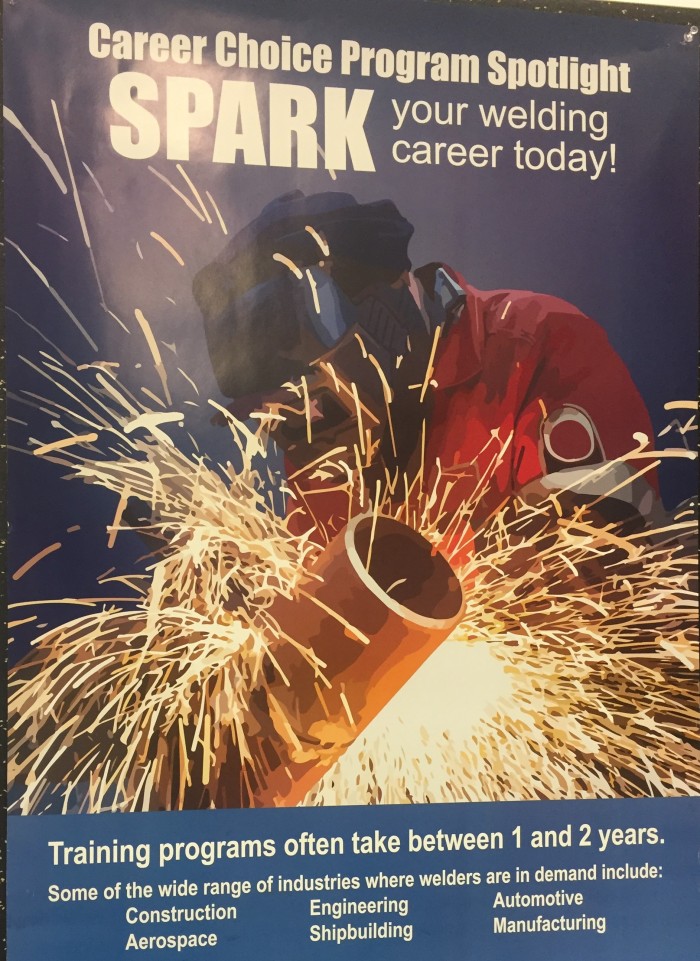Taking that first step to leave the path of social work was not easy. I invested a lot of time and energy learning how people worked. Years of classes, projects, homework, and tests were just going to be shelved and forgotten. Granted, I wasn’t getting anywhere by wishing upon every star in the galaxy for that fabled phone call from a social service agency. Nonetheless, it was still sad and frustrating that I can’t put anything I learned into practice. So, after ignoring the cold reality social work route has reached a dead-end, I finally started research on a new track, welding.
The first steps to learning more about welding were terrifying for I was on my own. I didn’t have KAP (Kelly Autism Program) to hold my hand and no one in my family has ever taken this path before. I was taking a real-world risk were this was going to pay off or I will be worse off than I started. I was walking into this field on a wing and a prayer and the fear of failure was crippling. So much so I decided to tiptoe into this field by only taking the introductory course.
In Fall of 2016, I arrived early to my first day of class, expecting to walk into a classroom I have sat in a hundred times over. A plain and clean room facing a whiteboard with a teacher behind a podium. What I actually walked into was a gigantic industrial grade garage. Everywhere I looked the classroom(?) disorganized mess of large machines, powerful grinders, tanks of gases, and welders that were twice the size of what I used before. Even the air was saturated with the smell of hot iron and metal shavings, informing me that this room has been well used. I couldn’t see one clean place to sit down, I thought to myself “was this really a classroom?” It also occurred to me that it was a mistake to wear blue jean shorts and tennis shoes this morning.
That first day was spent looking over the syllabus, meeting our professor, meeting our professor’s assistant, meeting our new classmates, and raiding the workshop lockers for tools that have been abandoned by former students.
The first few weeks was split between doing bookwork at home and practice welding in the workshop. The bookwork was composed reading chapters, filling out workbook pages, learning terminology, and learning the individual parts of the welder itself. These sessions did not last long though. After reviewing 2 chapters from the book, the session shifted from lecture to an open lab.
The practice portion involved me actually using a welder to complete certain tasks. The first task I had to complete was drawing a straight line on a small plate of metal with the welder. Sounds insultingly simple, right? Maybe to expert metal-smith, but not to a novice like me. I can’t tell you how many hours (and curse words) I spent trying to get this project right. It seemed like anytime I pushed the nozzle of the weld gun to a piece of metal, all that would come out is a lumpy string instead of a straight line. After 15 or so tries, I realized that welding, although is a type of engineering, is not an exact science but a practiced art. There was hand-eye coordination, precision, technique, patience, and lots and lots of practice. When I learned that, the straight line got easier and I FINALLY was able to move the next project.
At times when I weld, I feel like I’m operating a paint brush instead of a fire-spiting gun. When I wasn’t working on my assignments, I was practicing in other ways. Sometimes my parents needed a trailer hitch for their lawnmower. Sometimes there would be some old chairs frames that needed to be repaired. And sometimes I felt like making some art.

More Sliverware Seaturtles

Skeleton Hand

Skeleton Fist

Skeleton Pease Sign

My First Metal Bird

Flock of Birds in a Tree

Flock of Birds in a Tree (2)

Flock of Birds (2)

Flock of Birds
Working on little projects like these are fun for me. I am finally becoming a craftsman and making something extraordinary out of ordinary. Now I get to finally walk in the footsteps of other metal artist. Not to mention, very informative for me. When I am tasked to fix or make something, I am learning about different materials, how to adjust my welder, and putting what I learned to practical use.
I’m not entirely certain where this new direction will take me. Will welding bring me fortune, adventure, or happiness? I don’t know, but I’m the one that made this decision for better or for worse and i know deep in my heart that it is a step in the right direction.































![IMG_0555[44]](https://autisticjourneyman.files.wordpress.com/2017/09/img_055544.jpg?w=700)